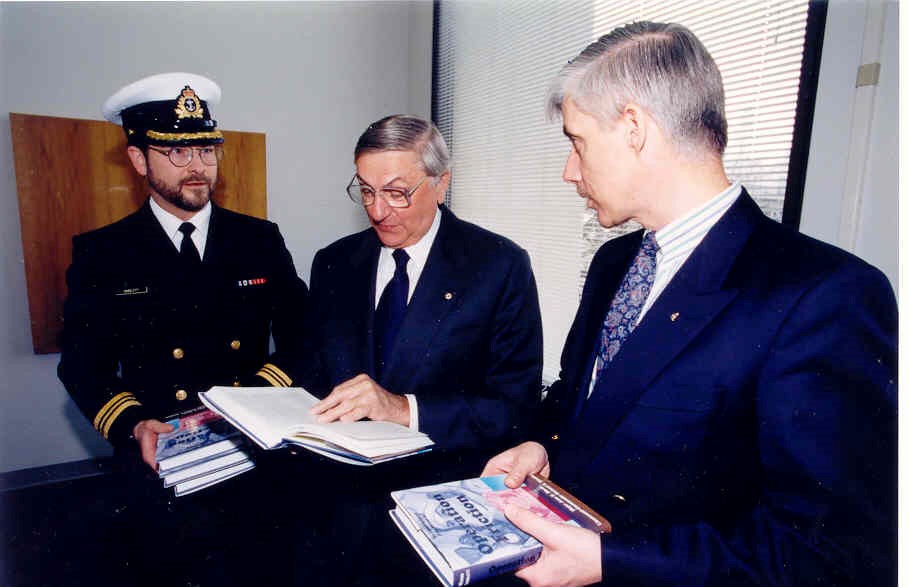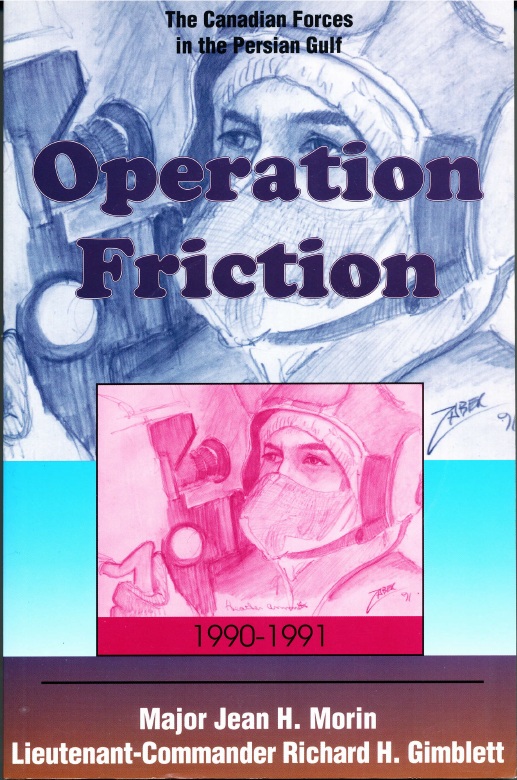Editor’s Note: The banner photo is a painting by Ted Zuber (1932 - 2018), Canada’s last war artist. Many of his paintings are in the Canadian War Museum. He also drew the cover art that is featured on the book Operation Friction by Rich and Jean Morin which is shown below. Ted was a sniper in the Korean War and is the only Canadian to have been awarded medals for both these Wars. He also happens to be the uncle of 12357 Steve Zuber from our Class of 79!
Rich and 10004 jean morin with governor-general romeo leblanc at the book launch in 1997
Rich served as the combat officer with the replacement crew of hmcs protecteur
While doing some research for Op Friction, it came to our attention that 12033 Jocelyn Cloutier had been deployed as part of the First Gulf War. He was subsequently interviewed by one of the authors and is mentioned several times in the book “Operation Friction: The Canadian Forces in the Persian Gulf” by LCdr Rich Gimblett and Major Jean Morin, from the Dundurn Press.
During the build-up, the book notes on page 121 that the “preparation of the officers at Kingston had been up to the Senior Staff Officer for Operations, who was supposed to be an air force officer of Lieutenant-Colonel rank. But Air Command was unable to provide an officer of this rank. In his place, Major Jocelyn Cloutier, a pilot of 433 Porcupine CF-18 Squadron from Bagotville, was selected. According to Cloutier, he was chosen ‘to fly a fighter desk’. Under the direction of Cloutier, another CF-18 pilot and two air weapons controllers shared permanent responsibility on the J3 Air Desk”. Shortly thereafter he and the others were deployed to Manamah, Bahrain.
Later, on page 162, the book notes: “The Shield had turned into a Storm. On board the carrier USS Midway, Major Jocelyn Cloutier was on duty with the naval air staff in its operations room when the air offensive began. He had been detached on 5 January from his position on the air staff at the Manamah headquarters to act as a liaison officer on board Admiral March’s Arabian Gulf Battle Force flagship, and had a duty shift with the naval air staff operations room. Because of the way the tours of duty worked out, Major Cloutier was tasked to issue the code word for Warning Red – Weapons Free, the authorization for the units afloat to open fire at will to protect the fleet against enemy counterattacks. At the end of the watch, as Cloutier later recalled, Admiral March returned his salute and joked, ‘If things turn out badly, I can always say it was the Canadians who started it …’. By 0600 (2200EST), the first night of the DESERT STORM air war had ended. Out of 2,388 air sorties made in three main attack waves, only three coalition planes were lost: one each from the United States, Britain, and Kuwait”.
The fact that Jocelyn was even serving on board the American Admiral’s flagship, USS Midway was due in no small part to his own negotiating skills. The book on pages 180-181 highlights the fact that the Canadian theatre commander Commodore Summers had arranged a meeting with Admiral March on New Year’s Day 1991 and brought along Major Cloutier and Commander Forcier. While the Commodore was behind closed doors with the Admiral, Major Cloutier discussed the Canadian air task group with his American hosts. “From their base in Doha, Colonel Engstad and Colonel Lalonde had long advocated establishing a direct link with the American flagship staff, which would close the Doha-Manamah-Riyadh-Aegis cruiser planning and tasking loop. Anticipating a greater volume of activity in the northern Gulf skies with the arrival of the four carriers, as well as direct American tactical control over the Canadians during the hostilities, Cloutier advocated a close liaison with the air planning staff aboard the new flagship. By the time Commodore Summers’ delegation departed, Admiral March had agreed that two Canadian staff officers – one air and one Navy - would embark in Midway to serve with the flagship staff as of 5 January.”p



